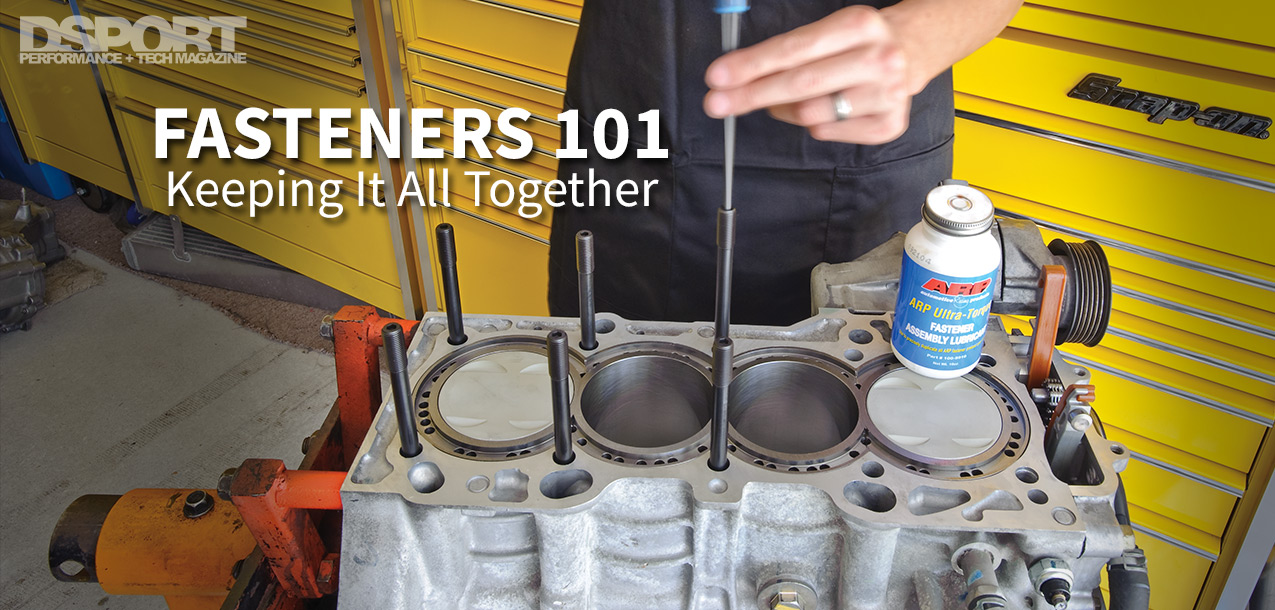A Head of the Rest
When power levels are multiplied, the weak points of an engine’s design become apparent. Typically, the factory connecting rods and pistons represent the obvious weakest links. As a result, most tuners correctly upgrade these components during the engine build. However, the engine’s head fasteners are sometimes overlooked and the result is often a compromised head gasket seal. Considering that an engine that multiplies its power output also multiplies the stress on the head studs at nearly the same level, you have to question the sanity of any engine builder that relies on factory head bolts on a high-performance engine. Quality aftermarket head fasteners in a variety of alloys can provide a sealing solution for any application. To allow you to choose the proper head fastener for your application we are going to examine cylinder-head sealing factors, along with the science behind head fasteners.
Head Gasket Sealing
The head gasket and head fasteners are responsible for keeping the top half of your engine attached to the bottom half. The design of some engines inherently makes them better at maintaining a proper head gasket seal than other engine designs. The number of head fasteners used per cylinder, the diameter of the head fasteners and the quality of the material used in the head fastener will all play a role in determining how much power can be produced before the head lifts from the engine and the gasket seal is compromised. Engines that are designed with five fasteners around each cylinder will be less susceptible to head gasket failure when compared to an engine designed with four fasteners around each cylinder, all other factors being equal. Engines that use 12mm fasteners will have a sealing advantage over engines using 11mm or 10mm fasteners. Finally, the quality of the fastener material will also play a critical role. In comparing two identically sized fasteners of different materials, an ultra-high-strength 260,000 psi (tensile-strength) alloy fastener would deliver 37-percent more clamping force than a high-strength 190,000 psi (tensile-strength) fastener. If you are planning on increasing the power output of your engine more than 40-percent above the factory levels, you need to consider improving the head gasket seal of your engine. A quality multi-layer-steel (MLS) head gasket with a precision, surface ground finish is a must while quality high-performance head bolts or head studs should also be on your parts list.
 Bolts undergo twisting to establish torque. A stud and nut combination ensures stretching and tension on a single axis.
Bolts undergo twisting to establish torque. A stud and nut combination ensures stretching and tension on a single axis.
Bigger, Better or Both?
For most high-performance builds where the engine power is doubled or even tripled over the factory output, the off-the-shelf 8740 alloy head bolts or head studs should perform flawlessly. If you are planning to go beyond this horsepower level, there is a chance that you will need to look into either increasing the size of the fasteners or upgrading the material of the fasteners (or possibly employing a combination of both strategies). On high-horsepower Toyota Supra engines (2JZ-GTE), a number of engine builders re-tap the cylinder block to accommodate 1/2-inch studs. In comparison to a 12mm stud, a 1/2-inch stud delivers 10-percent more clamping force. Additional clamping force can also be obtained with a higher-strength alloy torqued to a higher setting. An ARP 2000-alloy fastener would also deliver a 10-percent increase in clamping force compared to the standard high- performance ARP 8740 alloy. If even more clamping force is needed, ARP can produce custom head fasteners out of an L19-alloy. The L19-alloy fastener would deliver a 30-percent increase in clamping force compared to the 8740 alloy or a 19-percent increase over the ARP 2000 alloy. Cosworth also offers H11 tool steel head studs for select applications. The H11 tool steel is also rated at 260,000 psi for ultimate strength. When an engine is modified to produce more than five times the original output, it’s possible that a combination strategy of both bigger and better head fasteners may be needed. Hence the 10-percent advantage of going to a larger 1/2-inch stud from a 12mm stud could be combined with the 30-percent advantage delivered by using the L19 or H11 alloy in place of the 8740 alloy.
 Factory main bolts can be replaced with aftermarket mains if studs are not desired.
Factory main bolts can be replaced with aftermarket mains if studs are not desired.
Torque Specs w/ ARP Moly (ib-ft)
| Alloy | 8740 | ARP2000 | L19 |
|---|---|---|---|
| Tensile Strength | 190Kpsi | 220Kpsi | 260Kpsi |
| Stud Diameter | – | – | – |
| 10mm | 60 | 68 | 80 |
| 11mm | 71 | 79 | 93 |
| 12mm | 86 | 96 | 113 |
| 1/2 | 95 | 105 | 124 |
Clamping Force @ Recommended Torque
| Alloy | 8740 | ARP2000 | L19 |
|---|---|---|---|
| Tensile Strength | 190Kpsi | 220Kpsi | 260Kpsi |
| Stud Diameter | – | – | – |
| 10mm | 12,015 | 13,350 | 15,777 |
| 11mm | 15,998 | 17,775 | 21,007 |
| 12mm | 17,483 | 19,425 | 22,957 |
| 1/2 | 19,116 | 21,240 | 27,193 |


